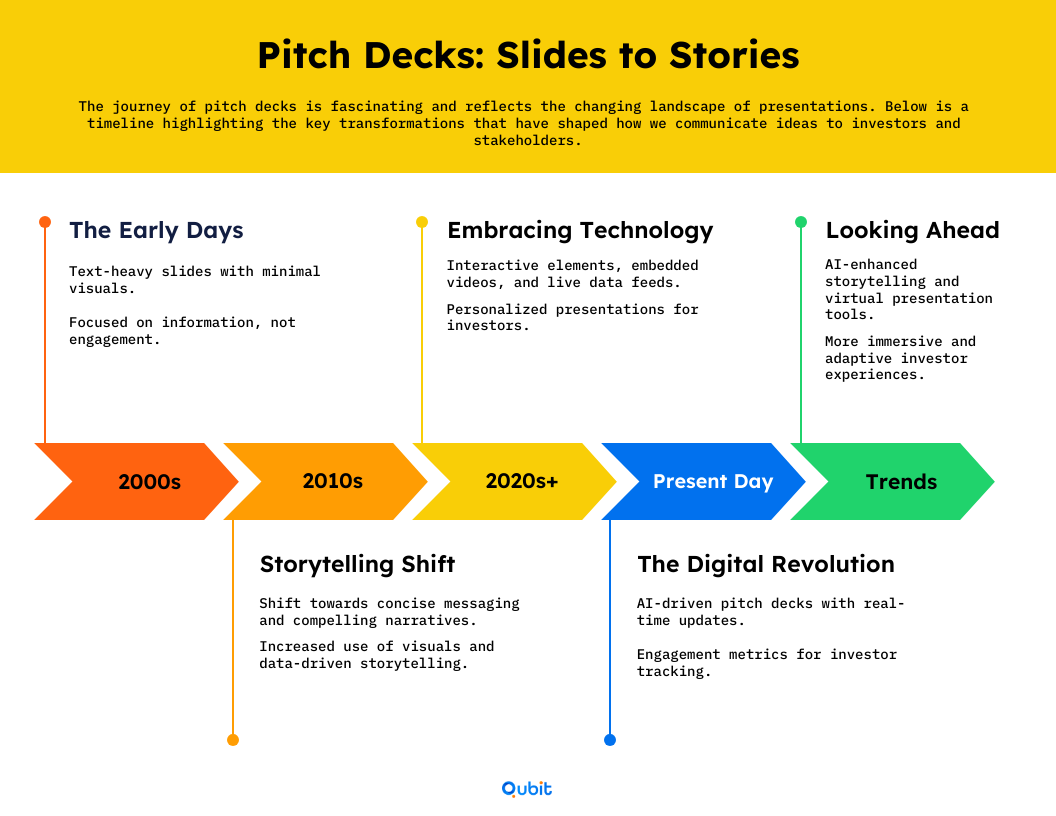2 minutes and 12 seconds. That’s all the time venture capitalists spend on average reviewing pitch decks. That short window highlights the need for a good pitch deck—one that grabs interest immediately. Over time, pitch decks have changed from simple slide presentations to dynamic, data-driven stories that tell a compelling narrative.
This guide will help you understand how to make pitch deck strategies work for investor-specific customization. This ensures your presentation stands out. Whether you’re refining your concept or already drafting slides, understanding winning pitch fundamentals is essential before exploring more tailored investor-centric strategies.
Fundamentals of a Pitch Deck
Key Components
A good pitch deck is more than just a visual presentation—it’s a strategic tool designed to capture investor interest. At its core, it provides a clear summary of your business. This includes your value proposition, market opportunity, business model, financial projections, and growth strategy. Each component engages stakeholders, answering key questions while sparking curiosity.
The effectiveness of a pitch deck lies in its ability to balance storytelling with hard data. Entrepreneurs often include charts, graphs, and other visuals to highlight key metrics that support their narrative. Also, the deck’s structure must flow logically. It should start by introducing the problem, then present your solution, and end with a compelling call to action.
Evolution from Basic Slides to Digital Narratives

Pitch decks have evolved significantly over the years. In the past, they were simple slide presentations—static, text-heavy, and often lacking in engagement. Today, they are dynamic and data-driven, incorporating interactive elements, animations, and even real-time updates. This shift reflects the growing need to adapt to diverse audiences and the increasing role of storytelling in business communication.
Modern pitch deck best practices emphasize the importance of tailoring the presentation to the audience, whether it’s angel investors or venture capitalists. Digital tools now offer capabilities to personalize decks, incorporating audience-specific insights.
Design Principles in a Good Pitch Deck
The design of a pitch deck is as critical as its content. Clarity, brevity, and visual appeal are key principles. Use clean layouts, cohesive color schemes, and minimal text to ensure your message stands out. Above all, integrate storytelling to make your pitch memorable.
A focus on powerful presentations is critical, as it lays the groundwork for effective pitch deck creation, a crucial element in capturing investor interest. By weaving compelling narratives with clear financial metrics, you enhance persuasiveness, ensuring your pitch resonates long after it’s delivered.
Evolution and Variations of Pitch Decks
Pitch decks have evolved significantly since their inception as simple, text-heavy presentations. Today, they are dynamic tools designed to captivate audiences while effectively conveying a narrative. Understanding the transformation of pitch deck formats can provide valuable insights into what makes a good pitch deck.
Investor Decks
Investor decks focus on persuading potential investors by highlighting the business opportunity, financial projections, and scalability. A good pitch deck in this category typically uses concise slides supplemented by visuals to clarify metrics. These decks prioritize storytelling and data, ensuring that investors grasp the value proposition quickly.
Partnership and Demo Decks
Partnership decks showcase collaborations, emphasizing mutual benefits. They often include case studies, testimonials, and partnership milestones. Demo decks, meanwhile, are product-centric and rely on interactive elements or live demonstrations to highlight usability and innovation.
Digital and Interactive Decks
The rise of digital enhancements has revolutionized pitch decks. Interactive decks integrate multimedia elements like videos, clickable links, and animations, offering a more engaging experience. These formats demonstrate what makes a good pitch deck by blending impactful design with technology.
From static slides to immersive presentations, pitch decks continue to adapt, reflecting the growing demand for clarity, creativity, and connection.
Key Slide Components for Investor Clarity
When crafting a good pitch deck, each slide should serve a specific purpose, capturing investor attention and effectively communicating key messages. A well-structured deck for investors ensures clarity, conciseness, and engagement, leaving a lasting impression.
Overview of Key Slide Components
A pitch deck typically includes slides that address essential aspects of your business. These components should align strategically to tell a compelling story:
- Introduction Slide: Company logo, tagline, mission—set the stage.
- Problem Statement: Define the core issue and why it matters to the market.
- Solution Slide: Your value proposition and how you uniquely solve the problem.
- Market Opportunity: Data on market size, growth projections, and customer segments.
- Business Model Slide: How you generate revenue and unit economics.
- Traction & Milestones: Key achievements, user/customer growth, and timeline to date.
- Competitive Landscape: Differentiators, barriers to entry, and positioning versus rivals.
- Team Slide: Founders’ backgrounds, relevant expertise, and advisory board.
- Financial Projections: 3–5 year forecasts with main assumptions and visuals.
- Ask & Use of Funds: Funding required, allocation plan, and expected impact on growth.
Critical Information to Include
To ensure investor clarity, prioritize straightforward, impactful details:
- Business Model: Clear revenue streams, unit economics, and scalability.
- Financials: High-level projections, break-even analysis, and main KPIs presented visually.
- Team: Founders’ bios, key hires, and advisory board strengths.
- Traction & Milestones: User/customer growth, partnerships, and achieved benchmarks.
- Competitive Advantage: Unique IP, partnerships, or technology that sets you apart.
- Ask & Use of Funds: Amount sought, allocation breakdown, and runway impact.
Highlighting essential slide components ensures pivotal information reaches investors clearly. Each slide should be visually clean, with minimal text and a focus on key takeaways.
Tailoring Pitches to Investors: Engagement Strategies
Creating a good pitch deck isn’t just about presenting numbers—it’s about crafting a story that resonates with the specific investor in the room. To achieve this, tailoring your pitch deck to the audience is essential. Startups that adapt their pitches based on specific feedback experience 40% higher engagement with investors. Below, we explore actionable strategies to engage investors effectively through segmentation, storytelling, and strategic visual data presentation.
1. Investor Segmentation
Segmenting investors allows you to customize your message for different profiles. Start by categorizing investors based on their interests, industry focus, and investment stage. For example:
- Angel Investors: Early-stage backers who prioritize vision, team chemistry, and market potential over extensive data.
- Venture Capitalists (VCs): Seek scalable models, strong unit economics, and sizable exit opportunities—demanding thorough financials.
- Family Offices: Often make larger, patient investments across generations; respond well to mission-driven narratives.
- Corporate VCs: Strategic investors aligned with your industry—look for synergy, technology integration, and market expansion.
- Accelerators & Angel Networks: Offer funding plus mentorship and networking; value clear milestones and rapid traction.
2. Customizing Content for Angel vs. VC
A tailored pitch deck involves modifying content to suit the investor type. For angel investors, emphasize vision and qualitative data like market trends or testimonials. For VCs, focus on quantitative aspects such as ROI and a 3–5 year financial runway.
3. Storytelling Techniques
Storytelling is key to emotional appeal. Share your startup’s origin story and the problem you aim to solve. Use relatable anecdotes to create a connection and leave a lasting impression.
4. Effective Use of Data and Visuals
Combine storytelling with compelling visuals. Charts, graphs, and infographics should highlight key metrics such as user growth, revenue projections, and market opportunity. Present data concisely to avoid overwhelming your audience.
Effective investor engagement involves a lot more than this. Qubit Capital can help, offering many more Startup funding services in your entire fundraising journey.
In-Depth Case Studies and Success Stories
Real-world examples often reveal the true power of a good pitch deck. From securing seed funding to gaining investor trust, these success stories highlight how targeted strategies can deliver measurable outcomes. Let’s explore how companies like Airbnb, Buffer, and Uber crafted decks for investors that resonated with their audience.
Airbnb
Airbnb’s pitch deck is often cited as a masterclass in simplicity and storytelling. By focusing on clear visuals and concise messaging, the company raised $600k in seed funding. The deck emphasized the problem Airbnb was solving—helping people find affordable lodging—and presented a scalable solution backed by compelling market data. This example shows how a well-executed pitch deck can not only attract funding but also articulate a business’s unique value proposition effectively.
Buffer
Buffer’s pitch deck demonstrated the power of targeted outreach. Instead of a broad message, it focused on the specific needs of SaaS investors, highlighting Buffer’s recurring revenue model and customer acquisition strategies. This tailored approach helped the company secure $500k in funding. For founders aiming to build investor trust, the lesson is clear: Buffer’s pitch deck demonstrated the power of targeted outreach.
Uber’s Pitch Deck Example
Uber’s pitch deck stood out by emphasizing innovation and scalability. By showcasing its plans to disrupt transportation through cutting-edge technology, Uber attracted significant funding in its early stages. This example underlines the importance of demonstrating long-term vision while addressing immediate market needs.
Other Founders’ Pitch Deck Strategies
From smaller startups to industry disruptors, founders who understand their audience and tailor their pitch decks accordingly often achieve remarkable outcomes. Whether it’s focusing on market data, customer stories, or future scalability, a strategic approach makes all the difference.
Advanced Digital Engagement Trends in Pitch Decks
In today’s fast-paced investment landscape, a good pitch deck isn’t just about compelling visuals and concise messaging. Digital enhancements, such as real-time analytics and interactive elements, are transforming how pitch decks connect with investors and maintain engagement. Leveraging these tools ensures that presentations are not only informative but also dynamic and responsive to investor behavior.
Interactive Elements
Interactive elements like clickable infographics and real-time charts elevate the presentation experience. Instead of static slides, these features provide investors with the ability to explore key data points themselves. For example, interactive financial projections allow stakeholders to adjust variables and see immediate outcomes, fostering deeper understanding.
For teams wondering how to make pitch deck presentations more immersive, integrating live Q&A sessions or polls directly into the deck can also add value. These features encourage dialogue and demonstrate adaptability to investor feedback. Partnering with a reliable pitch partner can help refine these elements while ensuring technical precision.
Real-Time Analytics
Real-time analytics revolutionize how creators measure the effectiveness of their pitch decks. Tools that track engagement metrics—such as time spent on each slide or click-through rates—offer valuable insights. These metrics allow presenters to identify what resonates most with investors and adjust their strategies accordingly.
Digital Engagement Metrics
Digital engagement metrics, including open rates and interaction levels, play a pivotal role in evaluating pitch deck performance. Incorporating these metrics into your strategy aligns with pitch deck best practices, ensuring presentations remain relevant and impactful in a digital-first world.
Best Practices and Expert Tips for Pitch Deck Presentations
Creating a good pitch deck requires more than just slides—it demands a compelling narrative, clear delivery, and thoughtful preparation. Below, we explore three essential components: timing your pitch, mastering storytelling techniques, and perfecting rehearsal strategies.
Expert Advice: Why Now?
Timing matters significantly in pitch presentations. Investors often listen to numerous pitches in a day, so aligning your narrative with current market trends or industry shifts can help you stand out. Begin by demonstrating why your business is positioned to succeed now. For instance, leveraging recent technological advancements or responding to emerging consumer needs can frame your idea as timely and relevant.
Integrating compelling value propositions into your pitch deck clarifies your business’s distinct strengths and can significantly capture investor interest. For startups aiming to differentiate themselves, aligning your timing with investor priorities is key.
Storytelling Techniques
A memorable pitch deck connects emotionally with its audience. Structure your story to highlight a problem, your solution, and the impact. Use visuals and anecdotes to create a narrative arc that resonates. For example, illustrating customer success stories or market impact can make your pitch more relatable.
Rehearsing Your Pitch
Preparation is crucial for confidence and clarity. Here are some actionable pitch deck tips:
- Practice aloud: Rehearse until you achieve a natural, confident delivery.
- Record yourself: Review video/audio to catch pacing, filler words, and clarity issues.
- Simulate investor questions: Anticipate hard questions and craft concise, data-backed answers.
- Time your pitch: Ensure your presentation, including Q&A, fits within the allotted slot to respect investors’ schedules.
By combining narrative alignment, storytelling, and rehearsed delivery, your pitch can leave a lasting impression.
Refining and Finalizing Your Pitch Deck
Perfecting your pitch deck involves more than crafting slides; it’s about ensuring the presentation is polished, clear, and impactful. Below, we’ll explore the essential steps to prepare your pitch deck for success.
Final Rehearsal
Rehearsing your presentation is crucial for a seamless delivery. Focus on timing, flow, and clarity. Practice speaking naturally, avoiding a robotic tone, and ensure you’re comfortable with transitions between slides.
- Record your rehearsals to identify areas needing improvement.
- Test your pitch on diverse audiences to gauge their reactions.
- Refine your pace to match your audience’s attention span.
A good pitch deck isn’t just visually appealing—it’s a narrative that resonates.
Feedback Incorporation
Soliciting feedback is vital for refining your pitch. Share your deck with trusted advisors, mentors, or colleagues who can offer constructive criticism. Incorporating feedback can significantly enhance your pitch's effectiveness, improving success rates by 30%.
- Pay attention to comments about clarity, structure, and visual design.
- Prioritize feedback that aligns with your core objectives and audience.
- Make adjustments to ensure a streamlined message.
Research reveals that presentations with a clear message are 43% more persuasive—feedback can help you get there.
Polishing Your Presentation
The final step involves perfecting every detail. Check for consistency in fonts, colors, and formatting. Ensure your slides are visually balanced, avoiding overcrowding.
- Simplify text-heavy slides for better readability.
- Include data visuals that complement your narrative.
- Revisit your opening and closing slides to leave a lasting impression.
By mastering these steps, you’ll learn not only how to make a pitch deck but also how to deliver a compelling story.
Conclusion
Throughout this blog, we’ve explored key strategies for crafting a pitch deck that resonates with investors and effectively communicates your vision. From employing a clear narrative structure to backing your claims with compelling data, every element contributes to a presentation that stands out. A pitch deck isn’t just about visuals or bullet points—it’s a synthesis of storytelling, market awareness, and strategic insight.
Ultimately, the success of a pitch deck hinges on its ability to engage the audience, anticipate questions, and showcase the unique value of your startup. By applying the principles discussed, you can transform your presentation into a powerful tool for securing funding and building lasting partnerships.
If you’re ready to create a pitch deck that captures attention and drives results, we’re here to help. Explore our Pitch Deck Creation service to unlock tailored solutions designed to bring your vision to life. Let us collaborate to turn your ideas into impactful presentations that make a lasting impression.
Key Takeaways
- A good pitch deck integrates narrative storytelling with data-driven metrics for maximum impact.
- Customizing content for investor segments enhances engagement and funding potential.
- Essential slide components and clear financial projections are critical to success.
- Real-world case studies provide actionable insights into effective pitch decks.
- Digital engagement trends and interactive elements are shaping modern pitch presentations.
Frequently asked Questions
What should an investor pitch deck contain?
An investor pitch deck should include a clear problem statement, your innovative solution, detailed market analysis, an overview of your team, realistic financial projections, and a strong call-to-action. These elements address investors’ key concerns and present your business as a promising investment opportunity.


 Back
Back



